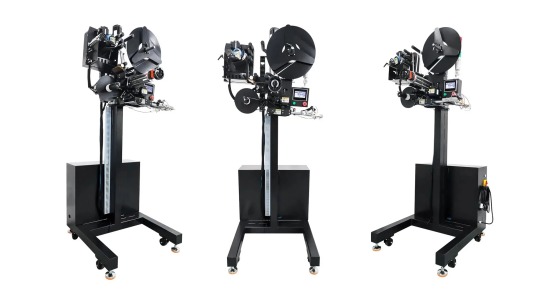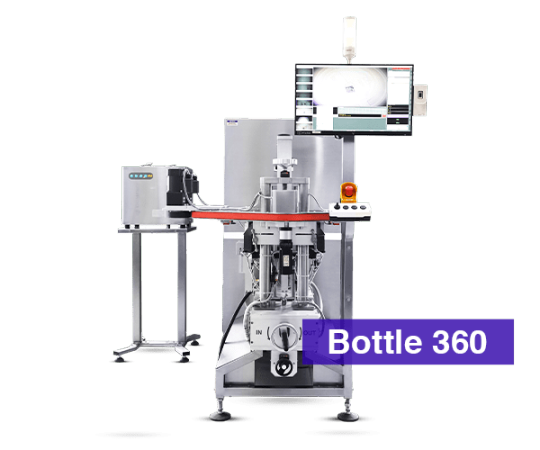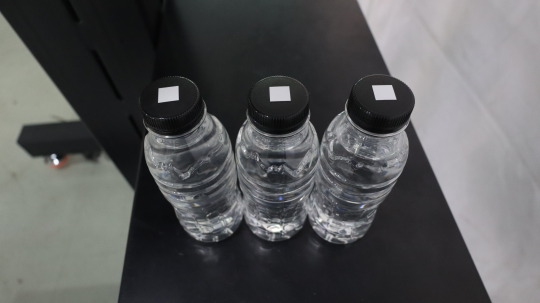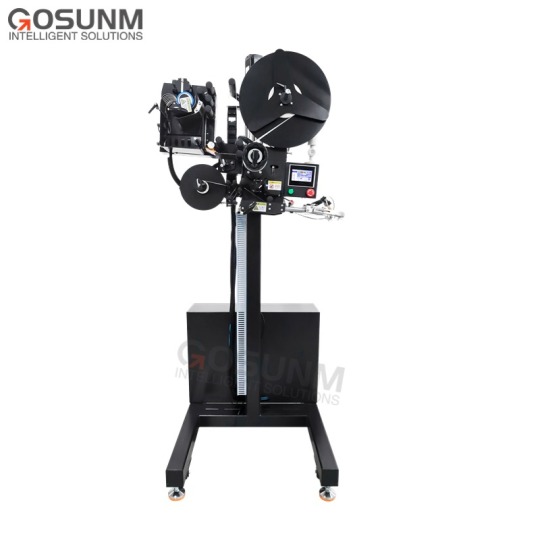#high-speed bottle cap QR code labeling machine
Explore tagged Tumblr posts
Text
High speed bottle cap QR code labeling machine
With the rapid development of digitalization, product traceability has become an important means for enterprises to improve quality management and enhance consumer trust. To meet market demand, gosunm launched a high-speed bottle cap QR code labeling machine, which provides efficient and reliable labeling solutions for food, beverage, medicine, daily chemical and other industries with a labeling speed of 200 meters per minute and accurate data traceability function.

High-speed labeling, efficiency and precision
Traditional labeling equipment often affects production efficiency due to problems such as slow speed and inaccurate positioning. Gosunm's high-speed bottle cap QR code labeling machine uses a high-precision servo drive system and intelligent visual positioning technology to ensure a labeling speed of up to 200 meters per minute, while the labeling accuracy error is controlled within ±0.5mm. Whether it is a round, square or special-shaped bottle cap, the equipment can fit stably, greatly improving the efficiency of the production line and reducing the need for manual intervention.
QR code traceability, enabling full-link management
The device supports one item and one code, and can print or paste QR codes containing information such as production date, batch number, and raw material source. Consumers can scan the code to check the authenticity and circulation path of the product, and companies can optimize the supply chain and prevent counterfeiting and counterfeiting through background data analysis. For example, after a well-known Russian beverage brand adopted this equipment, the product complaint rate dropped by 30% and the market inspection efficiency increased by 50%.
Modular design, flexible matching of production lines
The equipment adopts a modular structure, which can adapt to different bottle cap sizes and labeling positions (top surface, side, etc.), and supports a variety of labeling methods such as hot melt adhesive and self-adhesive adhesive. In addition, the intelligent control system can seamlessly connect to enterprise management systems such as MES and ERP to achieve real-time data synchronization and help build intelligent factories. It is not only a labeling tool, but also the "intelligent center" of the production line. It supports optional coding machine or inkjet printer modules to directly print date, batch number, barcode and other information on the label or product, eliminating secondary processing and eliminating manual errors. It also supports online operation, which can run independently and seamlessly connect to the packaging assembly line to adapt to multi-scenario production needs.
Rich in mature cases, adapting to the needs of multiple industries
gosunm has been deeply involved in the labeling field for many years and has provided hundreds of high-speed labeling equipment for customers in the food, pharmaceutical, cosmetics, daily chemical products and other industries, accumulating rich practical experience. Typical cases include:
A dairy group: labeling on the inside of the bottle cap to achieve full traceability of low-temperature yogurt, and increase daily production capacity by 40%;
A pharmaceutical company: applied to oral liquid bottle caps, in line with GMP standards, and traceability data connected to the national supervision platform;
Daily chemical brand: paste anti-counterfeiting QR code on the pump head bottle cap to effectively curb the circulation of counterfeit products;
《Parameter Quick View》
✅Applicable scenarios: labeling of flat/curved items ✅Applicable specifications: bottle caps, books, boxes, cartons, etc. ✅Function expansion: support inkjet/coding modules ✅Online mode: standalone use or connected to the assembly line 🔥Using technology to increase efficiency, this is the charm of Gaozhen labeling equipment.
Gosunm is a manufacturer specializing in the production of fully automatic labeling equipment. We focus on the research and development and production of various types of labeling equipment, including fully automatic labeling machines, round bottle labeling machines, flat labeling machines, side labeling machines, printing labeling machines and other packaging inspection supporting equipment. Our products are widely used in many industries and can meet the labeling needs of different products. We sincerely welcome new and old customers to consult and purchase. We will provide considerate services to solve various labeling problems for you!
#high-speed bottle cap QR code labeling machine#high-speed labeling equipment#flat labeling machines#fully automatic labeling equipment#gosunm
0 notes
Text
End-to-End Quality: How Vision AI for Bottle Inspection Covers Labels to Caps
In the fast-paced world of packaging and manufacturing, every second and every defect matters. A misaligned label, a loose cap, or an incorrect fill level can lead to rejected batches, customer complaints, or even product recalls.
To address these challenges, forward-thinking manufacturers are turning to Vision AI for bottle inspection — a technology that offers end-to-end quality control across the entire bottle production line, from labels to caps.
What Is Vision AI for Bottle Inspection?
Vision AI combines computer vision with artificial intelligence to inspect bottles with extreme precision and speed. Unlike traditional machine vision systems, Vision AI doesn't just follow pre-set rules — it learns, adapts, and improves over time, identifying defects with increasing accuracy.
By using high-speed cameras and smart algorithms, bottle inspection by Vision AI can scan and analyze each bottle in milliseconds, ensuring flawless execution at every step.
Inspection Coverage: From Labels to Caps
Let’s explore how Vision AI inspects each part of the bottle in real-time:
1. Label Inspection
Checks alignment, orientation, and placement
Identifies torn, wrinkled, or misprinted labels
Verifies barcode/QR code readability
Detects faded or missing text
With Vision AI, label inspection becomes automated, accurate, and scalable across thousands of bottles per hour.
2. Body Inspection
Detects scratches, dents, discoloration, and cracks
Identifies foreign particles in transparent bottles
Ensures uniformity in shape and structure
This is crucial for ensuring both product integrity and brand consistency.
3. Fill Level Detection
Detects underfilled or overfilled bottles instantly
Works on transparent and semi-transparent containers
Helps prevent waste and maintain regulatory compliance
Vision AI reduces human error and improves product quality with consistent fill monitoring.
4. Cap and Seal Verification
Checks for missing, misaligned, or loose caps
Detects damaged or broken seals
Verifies cap color and type for SKU-specific packaging
In industries like beverages, cosmetics, and pharmaceuticals, cap integrity is critical — and Vision AI ensures nothing slips through.
Benefits of End-to-End Bottle Inspection by Vision AI
Benefit Outcome: Automated real-time inspection, no production delays or stoppages. Higher accuracy. Reduced false positives and rejections. Fewer recalls. Catch defects before they leave the factory floor. Data-driven insights processes using inspection analytics. Labour savings. Automate repetitive tasks to cut manual workload
Why Manufacturers Are Making the Shift
Manual inspection is prone to fatigue, inconsistency, and high labor costs. Even traditional machine vision can’t adapt to new defect types or packaging designs without reprogramming.
That’s why Vision AI for bottle inspection is fast becoming the industry standard. It allows companies to:
Scale operations without compromising quality
Detect hidden flaws invisible to the naked eye
Gain real-time visibility into production performance
Industries Benefiting from Vision AI Inspection
Beverages – for seal and fill level accuracy
Pharmaceuticals – for contamination and label compliance
Cosmetics – for flawless appearance and package consistency
Food & Condiments – for correct labeling and tamper-proof caps
No matter the sector, bottle inspection by Vision AI helps meet rising quality expectations with confidence.
Conclusion
From the smallest label misalignment to a critical cap defect, Vision AI provides full-spectrum inspection with unmatched speed and precision. It’s not just a tool — it’s a competitive advantage in the modern manufacturing landscape.
1 note
·
View note
Text
How AI and Machine Vision Are Revolutionizing Bottle Inspection Machines

Introduction
The demand for high-quality bottled products in industries such as beverages, pharmaceuticals, cosmetics, and chemicals continues to rise. To meet strict quality control standards, manufacturers rely on bottle inspection machines to detect defects, ensure proper labeling, and maintain product integrity. Traditional inspection methods, while effective, often struggle to keep up with high-speed production lines and complex defect detection requirements.
With the advent of Artificial Intelligence (AI) and Machine Vision, bottle inspection technology has undergone a revolutionary transformation. These advancements enhance accuracy, speed, and adaptability, reducing human intervention and improving overall production efficiency.
1. AI-Driven Defect Detection and Classification
Traditional bottle inspection machines rely on predefined rules and static algorithms, which can be limited in detecting complex or subtle defects. AI-powered systems leverage deep learning and neural networks to:
Identify a wide range of defects, including cracks, scratches, deformities, and contaminants.
Learn and improve over time, adapting to new defect patterns without requiring extensive reprogramming.
Minimize false positives and false negatives, ensuring more precise inspection results.
2. Machine Vision for High-Precision Inspection
Machine vision technology uses high-resolution cameras, sensors, and advanced imaging algorithms to inspect bottles at ultra-fast speeds. Key benefits include:
360-degree bottle scanning, ensuring complete coverage of surface defects and labels.
Real-time analysis enables immediate rejection of defective products without disrupting the production flow.
Multi-spectral imaging can detect imperfections invisible to the human eye, such as internal cracks or microscopic contaminants.
3. Automated Cap and Seal Integrity Verification
Proper capping and sealing are crucial in preventing leakage, contamination, and product spoilage. AI-powered inspection machines can:
Analyze cap alignment and torque to ensure proper sealing.
Detect missing or misapplied tamper-proof bands.
Assess pressure seals using non-invasive techniques to maintain product integrity.
4. Fill Level and Volume Detection with AI Precision
Accurate fill levels ensure compliance with industry regulations and consumer expectations. AI-based inspection systems use:
Advanced image processing algorithms to measure fill levels with high precision.
Infrared and X-ray technology to assess liquid volume in opaque bottles.
Predictive analytics helps manufacturers adjust filling processes in real time to prevent waste and inconsistencies.
5. Smart Label and Barcode Verification
Accurate labeling is essential for brand consistency and regulatory compliance. AI and machine vision enhance label inspection by:
Reading and verifying text, barcodes, and QR codes with optical character recognition (OCR).
Detecting misaligned, wrinkled, or missing labels.
Comparing label colors and designs to ensure consistency across production batches.
6. AI-Powered Contaminant Detection
Contamination in bottled products poses serious health risks and can lead to product recalls. AI-enhanced bottle inspection systems use:
X-ray and infrared imaging to detect foreign particles inside bottles.
AI-driven anomaly detection to differentiate between harmless variations and actual contaminants.
Real-time contamination alerts allow manufacturers to take immediate corrective actions.
7. Integration with IoT and Smart Manufacturing
AI-driven bottle inspection machines are increasingly integrated with Industry 4.0 technologies, enabling:
Cloud-based data storage and remote monitoring provide real-time insights into production quality.
Predictive maintenance, where AI identifies potential machine failures before they occur, reduces downtime.
Seamless communication with robotic automation systems, optimizing sorting and rejection processes.
8. Enhanced Speed and Scalability
Traditional inspection methods often struggle to keep pace with high-speed production lines. AI-powered machines can:
Process thousands of bottles per minute with minimal error rates.
Adapt to different bottle shapes and sizes without requiring extensive reconfiguration.
Scale with growing production demands, ensuring long-term investment value.
9. Reduction in Manual Labor and Costs
AI and machine vision drastically reduce the need for human inspectors, leading to:
Lower operational costs by minimizing labor-intensive quality control processes.
Increased accuracy and reliability, as AI-driven machines are not prone to human fatigue or errors.
Faster decision-making, as AI can analyze and classify defects in real time.
10. Regulatory Compliance and Quality Assurance
Manufacturers in the food, beverage, and pharmaceutical industries must comply with stringent safety and quality regulations. AI-based bottle inspection systems ensure compliance by:
Automatically generating compliance reports and audit trails.
Identifying deviations from regulatory standards in real time.
Providing actionable insights for continuous quality improvement.
Conclusion
The integration of AI and machine vision into bottle inspection machines has revolutionized quality control in manufacturing. These technologies enable faster, more accurate, and adaptive defect detection, ensuring that only the highest-quality products reach consumers. By leveraging AI-driven automation, manufacturers can enhance efficiency, reduce waste, and meet stringent industry standards—ultimately securing a competitive edge in an increasingly demanding market.
1 note
·
View note
Text
Enhancing Packaging Quality with Vision Inspection Systems: Best Practices

Introduction
In the manufacturing industry, packaging plays a crucial role in ensuring product integrity, consumer safety, and brand reputation. Any defects in packaging, such as misprints, improper sealing, or contamination, can lead to product recalls, regulatory penalties, and loss of customer trust. To combat these challenges, manufacturers are increasingly adopting vision inspection systems to enhance packaging quality. These advanced systems use high-speed cameras, artificial intelligence (AI), and machine learning to detect defects in real-time, ensuring consistent quality and compliance with industry standards.
The Role of Vision Inspection Systems in Packaging Quality
Vision inspection systems help manufacturers detect defects, ensure proper labeling, verify seal integrity, and improve packaging consistency. Using these automated solutions leads to higher efficiency, reduced costs, and improved product safety. Below are the key areas where vision inspection systems contribute to packaging quality:
1. Defect Detection and Rejection
Vision inspection systems identify a wide range of packaging defects, including:
Misaligned or missing labels
Damaged or deformed packaging
Incorrect barcodes or QR codes
Seal contamination or leaks
Incomplete product filling
By automatically rejecting defective items, these systems prevent subpar products from reaching consumers, reducing the risk of recalls and brand damage.
2. Label Verification and Compliance
Regulatory agencies such as the FDA, EU regulations, and ISO standards require accurate labeling of consumer products. Vision inspection systems verify labels for:
Correct ingredient lists and allergen warnings
Legible batch numbers and expiration dates
Accurate barcode and pricing information
By automating label verification, manufacturers can ensure compliance and prevent costly mislabeling errors.
3. Seal and Closure Inspection
Proper sealing is essential for maintaining product freshness and preventing contamination. Vision inspection systems check for:
Seal integrity in bottles, pouches, and cartons
Tamper-proof features
Improperly applied caps or lids
Detecting seal defects early reduces spoilage and enhances consumer safety.
4. Color and Print Quality Inspection
Packaging aesthetics significantly influence consumer purchasing decisions. Vision inspection systems analyze:
Color consistency and print clarity
Alignment of logos and text
Correct font sizes and spacing
This ensures that branding remains consistent across all products, reinforcing customer trust.
Best Practices for Implementing Vision Inspection Systems in Packaging
1. Choosing the Right Vision Inspection Technology
Manufacturers should select vision inspection systems based on their specific packaging needs. Key considerations include:
Camera resolution and speed for detecting minute defects
AI and machine learning capabilities for advanced defect classification
Integration with existing production lines to minimize disruptions
2. Calibrating Systems for High Accuracy
Proper calibration ensures that the system correctly identifies packaging defects without false positives. Regular adjustments based on product variations help improve accuracy and reduce unnecessary rejections.
3. Integrating Vision Inspection with Automated Feedback Loops
Connecting vision inspection systems to production controls enables real-time adjustments. If a defect pattern is detected, the system can trigger corrective actions, such as:
Adjusting label alignment
Modifying filling levels
Correcting sealing pressure
This proactive approach reduces waste and enhances overall efficiency.
4. Regular Maintenance and Software Updates
Vision inspection systems require ongoing maintenance to function optimally. Manufacturers should:
Regularly clean and calibrate camera lenses
Update software algorithms for improved defect detection
Train personnel on system operation and troubleshooting
5. Data Collection and Analytics for Continuous Improvement
Vision inspection systems generate valuable data on defect trends and packaging quality. Analyzing this data helps manufacturers:
Identify recurring defects and root causes
Optimize packaging materials and processes
Enhance predictive maintenance to prevent downtime
Real-World Applications of Vision Inspection in Packaging
1. Pharmaceutical Industry
Vision inspection systems ensure that drug packaging is accurate, sterile, and tamper-proof. They verify batch numbers, expiration dates, and proper sealing to comply with stringent regulatory requirements.
2. Food and Beverage Industry
In food manufacturing, these systems check for:
Contaminants in packaging seals
Correct ingredient labels and allergen information
Proper fill levels in beverage containers
3. Consumer Goods and Cosmetics
Vision inspection systems prevent misprints and packaging defects in cosmetics, personal care products, and household goods. This maintains brand consistency and ensures high-quality presentation.
The Future of Vision Inspection in Packaging
The future of vision inspection systems will be driven by:
AI-powered predictive analytics for defect prevention
Deep learning algorithms that continuously improve accuracy
5G and IoT integration for real-time monitoring and cloud-based analysis
As these technologies evolve, vision inspection systems will become even more efficient, intelligent, and indispensable in modern packaging operations.
Conclusion
Vision inspection systems are transforming packaging quality control by automating defect detection, ensuring compliance, improving efficiency, and reducing waste. Manufacturers can maximize the benefits of these advanced systems by implementing best practices such as proper calibration, real-time feedback integration, and data analytics.
0 notes
Text
QR code labeling machine: labeling equipment for traceable product quality
In the near future, Russia, Asia and some European countries will impose consumption taxes on imported carbonated drinks. Sugary drinks are considered taxable goods. Starting from July 1, 2023, sugary drinks will be subject to excise tax at the rate of 7 rubles per liter. It is expected that after the implementation of this law, the annual consumption tax collected in the Ural region of Russia alone will be as high as 30 million rubles. In the first four months of 2023, 1 million liters of carbonated drinks were released in the Ural region through electronic customs inspection. Most of the imported beverages in this region are: non-alcoholic highly carbonated drinks in 300ml to 2L aluminum cans, glass bottles or plastic bottles, with added sugar and flavorings. Gaoshang has developed a traceable product and anti-counterfeiting labeling machine to track and manage sales through the QR code on the bottle cap. Our QR code labeling machine-high-speed linear labeling machine can solve this problem very well. The quality and import source of the product can be traced through the QR code on the bottle cap, thus effectively helping our customers avoid buying fake products and collecting consumption tax in some countries.
youtube
In the production and processing of many products, the most common method is to label or engrave laser codes to identify the Panel ID and Piece ID of the current product, and the smart labeling machine is used to complete these actions. Not only the marking action is completed, but it can also be uploaded to traceability systems such as MES/FIS/ERP to achieve downstream or customer tracking. Contemporary society is increasingly dependent on electronic products, such as mobile phones. We can query the identity of the mobile phone through its IMEI and query the accessory supplier information from its internal accessory code. Therefore, traceability through identification is a must for every automated smart factory, especially in the food packaging industry.

In order to help customers achieve this goal, our company has specially developed an intelligent high-speed bottle cap QR code labeling machine, which can easily and perfectly realize the functions of identification and information uploading systems to help you solve traceability problems. Traceability system. Find product introductions, logistics centers through which the products flow, number of transshipments, information on various raw materials used in the products, etc. Able to achieve one code per product. Nowadays, using our QR code labeling machine can be said to realize the function of clear information query from demand construction to integration of production process control and logistics management. The one-object-one-code product traceability system comprehensively uses advanced Internet of Things, mobile Internet, QR code, RFID and other Internet of Things technologies, covering all aspects of packaging, warehousing, warehousing, logistics orders, transportation, sales, and terminal stores. The process is well documented. Consumers can watch the production process of the product, which also plays a supervisory role, and they will buy the product with more confidence.

Advantages:
1. High progress, fast speed, speed ≥6,000BPH
2. It can realize the adsorption and placement of printed roll labels.
3. Configure the printer to achieve real-time printing function.

#auto labeling machine#QR code labeling machine#High Speed Labeling Machine#labeling machine#Youtube
0 notes